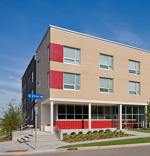Two Articles from the Winter Clarion Newsletter — December 20, 2012
The History of Clare Housing’s Caregivers
Every profession has its story. The story of the HIV caregiver in the Twin Cities is a colorful and rich one spanning 25 years.
It begins with Brother Louie, a Benedictine brother who had a personal and spiritual calling to serve people dying of AIDS. He opened the first home, Samaritan House, now called Damiano, in 1987. In those days the home served more as a hospice than a care home. Two years later the St. Joan of Arc church responded to the HIV/AIDS crisis in the community and converted the church’s rectory into a care home, naming it Grace House.
It is at these two homes where the role of a professional “AIDS caregiver” began to take shape. In those early years the caregivers wore many hats and provided the majority of services necessary to run the home. They provided bedside care, prepared meals, administered medication, and much more. They worked hand-in-hand with family members to provide end-of-life care to very ill residents. Volunteers were instrumental in helping take care of the residents at Grace House. There were 30-40 volunteers from the church who signed up for shifts around the clock.
The directors at Samaritan House and Grace House lived at the home where they were employed. This arrangement made the separation of one’s personal and professional life extremely challenging. Quickly, it was recognized that a live-in staffing model was not sustainable.
Nancy Wilke was one of the first professional HIV caregivers hired by Grace House and soon more professional support was put in place for those committed to doing this work. Training on self-care, professional boundaries, and other educational opportunities started to be offered to HIV caregivers by local organizations such as the Red Cross of St. Paul, Pathways, Minnesota AIDS Project, and others. Support groups were created for caregivers, facilitated by therapists or counselors, to support caregivers working in the field.
Today, Clare Housing caregivers and staff receive training and support on HIV disease and opportunistic infections, HIV medications, mental health and chemical dependency issues, diabetes management, traumatic brain injury, boundaries and self-care, and many other health and social issues. Although caregiving continues to be a multi-dimensional job, the infrastructure is in place to make the position a meaningful and sustainable one for both the caregiver and their residents.
Clare Housing currently employs 18 full-time and 24 part-time caregivers at our four community care homes. These dedicated caregivers provide compassionate care in a safe environment so the residents may achieve the highest level of stability and independence while maintaining their dignity at any stage of the illness.
This article is dedicated to the caregivers and staff (past and present) for their commitment and compassionate service.
~~~~~~~~
 Congratulations to Nancy Wilke for 21 years of Caregiving
Congratulations to Nancy Wilke for 21 years of Caregiving
When you step into Grace House II on almost any given day you are greeted with a smile by Nancy, the lead caregiver. This year is Nancy’s 21st year caring for people living with HIV/AIDS. Nancy began her journey of caregiving as a church volunteer visiting people who were sick and dying in the late ’80s.
When the disease hit the community she simply wanted to help people. There was little known about the disease, the transmission and treatment. “In those days people called it the gay disease and that was so ridiculous. How could a virus know if you’re gay or not,” says Nancy.
That lack of understanding and compassion is exactly why Nancy began her journey of caregiving in those early days when it was mostly end-of-life-care. She was there to hold a person’s hand, help bathe or feed them. But, mostly she was there when they felt hopeless and knew that they were dying.
In 1991, Nancy was offered a full-time position. Michele Boyer, program director, has been working with Nancy since 1998. “Nancy was instrumental in developing a system for the caregivers from the communication with the doctors to how medicine was dispensed and tracked,” says Michele.
Her attention to detail ensures that it will never feel like a nursing home, hospice or an institution. “Grace House II is a home. It just has to be. Our residents deserve that. Having stable housing is so important for people with HIV/AIDS. When you have 25 or more pills to take at maybe ten different times of the day or night, confusion and hopelessness can overtake a person. Serious depression is really common in people who don’t have a home, and who are trying to manage everything,” says Nancy.
For Nancy, Grace House II is more than a place to work. “I love coming to work, caring for the residents and working with the caregivers. It just doesn’t seem like a job. It’s my home too and I am inspired every day.”
Thank you Nancy for your commitment and passion to provide loving care and support to each of your residents.




You must be logged in to post a comment.